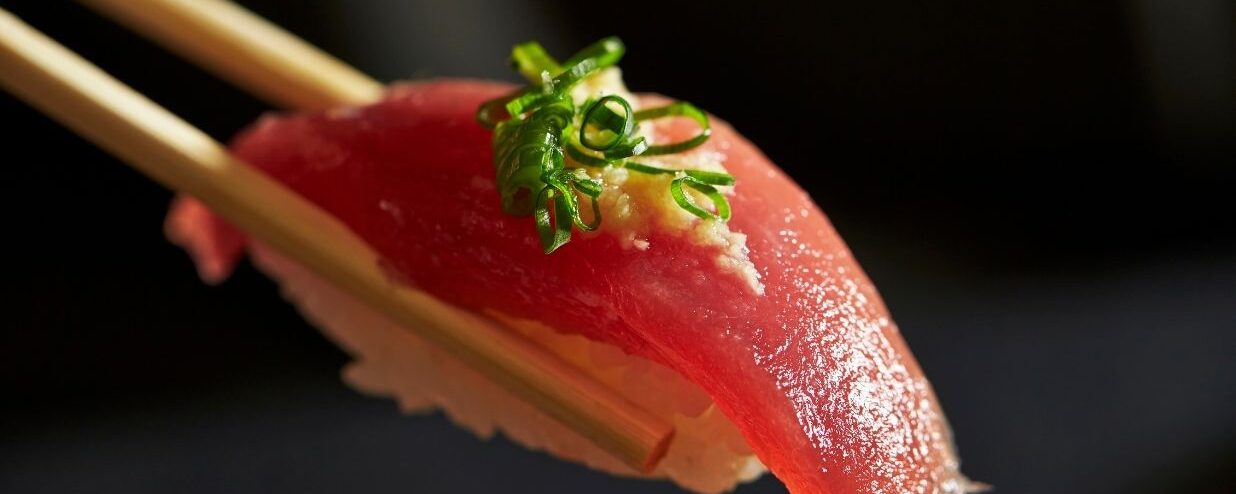You can’t visit Japan without trying sushi — and you shouldn’t leave without knowing how to say the different types of sushi in Japanese, either.
Unlike the Western-style sushi rolls topped with avocado, mayonnaise, or cream cheese, traditional Japanese sushi is much simpler. If you ever go to an omakase restaurant in Japan, sushi is molded to highlight two key elements: the neta (the fish or topping) and the shari (the seasoned rice). There are many varieties of sushi in Japan, using different kinds of fish, shellfish, and preparation styles, and a lot of them go beyond the usual salmon and tuna toppings.
So, how do you differentiate nigiri with sashimi, or maguro with anago? In this article, we’ll explore the most common types of sushi and how to say them in Japanese, so you can order like a local.
Types of Sushi in Japanese
Not all sushi is created equal. The oldest form of sushi is narezushi, which originated in Southeast Asia. This traditional style involves fermenting fish with salt and rice, but unlike modern sushi, the rice is discarded after fermentation.
The sushi we’re familiar with today became popular in Tokyo when the city was still called Edo, around the early 19th century. This new style of sushi was created as a quick and convenient meal to suit the fast-paced life of Edo’s bustling streets. You may also hear restaurants mention Edomae sushi, which literally means “sushi in front of Edo,” referring to sushi made with fresh fish caught in Tokyo Bay.
Over time, various types of sushi have emerged, including sushi rolls (maki), hand rolls (temaki), gunkan (battleship sushi), and more. Here are some common sushi types you should know!
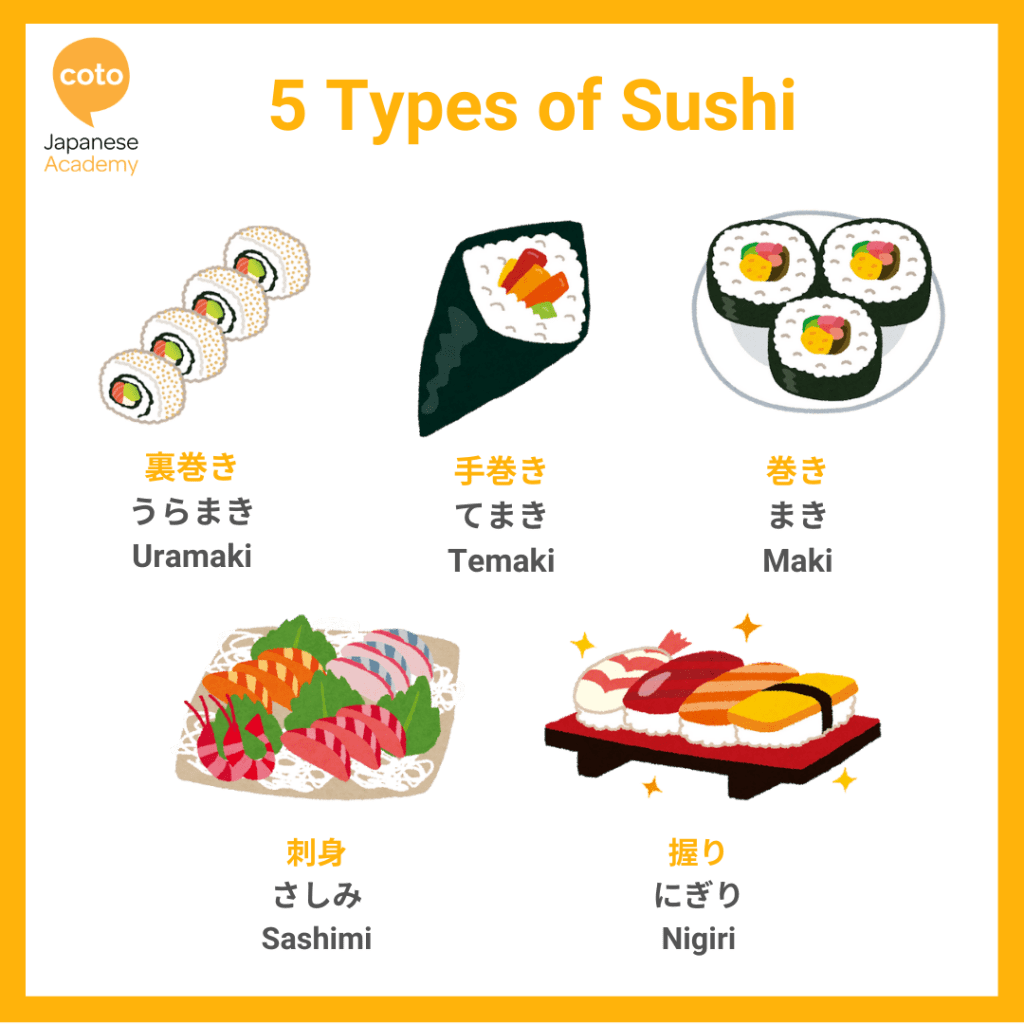
1. Uramaki Sushi (裏巻き寿司/うらまきずし)
Although Uramaki sushi (uramakizushi) is very popular in the West, it is actually not very common in Japan.
The word urumaki comes from 裏 (ura), meaning “back” or “inside,” and 巻き (maki), meaning “roll.” It refers to sushi rolls where the rice is on the outside and the seaweed (nori) is on the inside. Popular examples of uramaki in the West include California rolls, dragon rolls, and similar styles.
2. Temaki Sushi (手巻き寿司/てまきずし)
Temaki sushi 手巻き寿司 (temakisuzhi) means “hand rolled sushi”. It is a popular house-party food, due to its being easy to serve.
As the name implies, temakisushi is rolled up by hand. The seaweed is on the outside, and people can often customize what they want to put inside it. Next time you need to prepare dinner for a lot of people, consider serving temaki sushi!
3. Maki Sushi (巻き寿司/まきずし)
Similar to temaki sushi, maki sushi (makizushi) is rolled with the seaweed on the outside, with rice inside, and fish in the middle. Maki sushi is far more popular at sushi restaurants in Japan than uramaki sushi, and maki sushi rolls are often eaten last due to their rich flavor.
4. Sashimi (刺身/さしみ)
Sashimi isn’t exactly sushi — it’s thinly sliced raw fish (or meat), typically served chilled on ice with soy sauce and wasabi.
Although sashimi is different from sushi, it’s commonly served at Japanese sushi restaurants as well as at izakaya (Japanese pubs). That’s why we’ve included it in our list!
Sashimi isn’t always limited to fish. For adventurous eaters, some Japanese restaurants offer horse sashimi and even chicken sashimi. And for the truly daring, there’s fugu sashimi — thinly sliced pufferfish known for its deadly poison, which is potent enough to kill several adults if prepared incorrectly. Because of this, fugu must be carefully prepared by licensed chefs.
5. Nigiri (握り寿司/にぎりすし)
This is the most popular form of Japanese sushi in Japan. Often prepared by hand, and served as 2 pieces. Nigiri sushi is raw or cooked fish on top of a small ball of rice, sometimes with some wasabi inside.
Types of Sushi Toppings in Japanese
Now that we’ve covered the most common types of sushi, let’s move on to the most popular sushi toppings — the delicious fish and seafood that make sushi so special!
1. Maguro Sushi: Tuna
Maguro is the Japanese word for tuna, one of the most popular and widely enjoyed sushi toppings. It has a rich, meaty flavor, and has different options for flavor and texture depending on the part of the fish that it comes from, including lean (akami), medium-fatty (chutoro), and fatty (otoro), with otoro being the prized, melt-in-your-mouth part of the tuna belly.
本まぐろ – honmaguro – is Pacific bluefin tuna.
2. Saamon Sushi: Salmon
Did you know that salmon is not traditionally a Japanese sushi? That’s because salmon doesn’t naturally swim in Tokyo Bay, the source of many classic sushi fish.
Salmon sushi was actually introduced to Japan in 1995 by a Norwegian who demonstrated that farmed salmon, raised on controlled feed and guaranteed to be parasite-free.
Fun fact: サーモン (saamon) used for making sashimi and sushi in Japan is Atlantic Salmon. Japanese sake/shake (鮭) means Chum salmon (シロザケ), and should not be eaten raw!
3. Ikura: Salmon roe
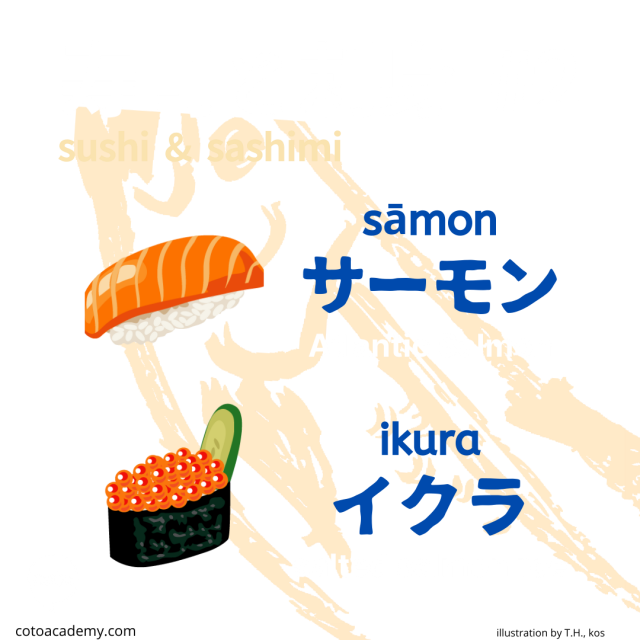
Ikura refers to salmon roe, bright orange fish eggs that are salty, juicy, and burst with flavor. It’s a popular sushi topping known for its unique texture and rich, slightly briny taste. Ikura is often served piled generously on a small bed of rice wrapped with a strip of seaweed, known as gunkan-maki or “battleship sushi.”
4. Ika: Squid
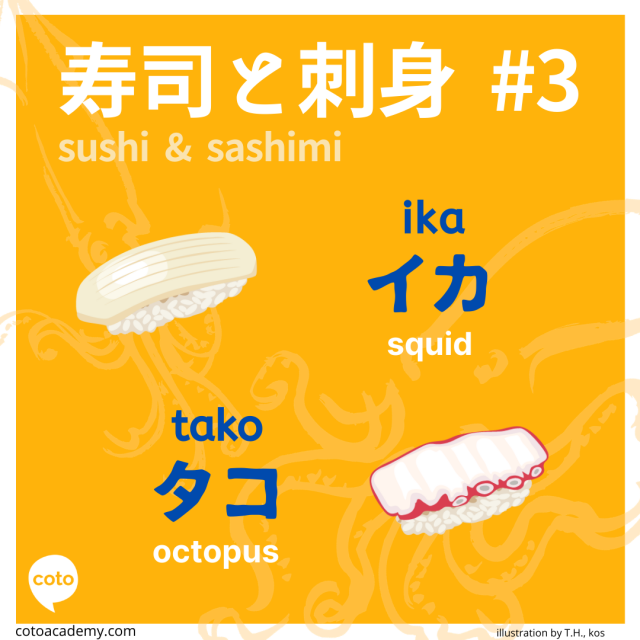
Ika means squid in Japanese and is a popular sushi topping known for its smooth, slightly chewy texture. Served raw, ika has a mild, sweet flavor that pairs well with soy sauce and wasabi. It’s often sliced thinly to highlight its delicate taste and can sometimes be scored to make it more tender.
When fresh, it tastes sweet and tender, but if it’s not fresh, it becomes tough and rubbery.
5. Tako: Octopus
Tako (蛸), or octopus, and ika are both considered “light” flavored fish. Tako means octopus in Japanese and is a common sushi topping. It has a firm, slightly chewy texture with a mild, slightly sweet flavor. Tako is usually boiled before serving to soften it and bring out its natural sweetness. It’s often sliced thinly and served as nigiri or in salads and appetizers.
6. Ebi Sushi: Shrimp
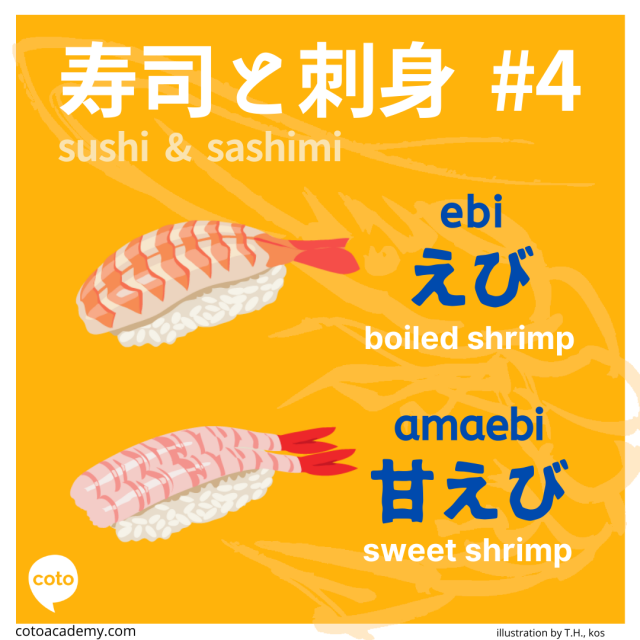
Did you know that Japanese sushi serves multiple types of shrimp, or 海老? Ebi means shrimp in Japanese and is a popular sushi topping. Typically, shrimp is boiled before serving, giving it a sweet and tender texture. There are different types of ebi used in sushi, including the common amaebi (sweet raw shrimp), which is served raw and prized for its delicate sweetness, and regular boiled shrimp used as nigiri.
Here are some of the other types of shrimp used in sushi!
- 海老 – ebi – shrimp
- 甘えび – amaebi – sweet shrimp (commonly served raw)
- ぼたん海老 – botan’ebi – Jumbo shrimp (plumper and larger than amaebi with similar taste.)
- 車海老 – kurumaebi – Japanese tiger prawn (commonly used for Edomae-style sushi)
7. Akagai: Red clam
Shellfish, called gai or kai (貝) are also popular picks for sushi. Akagai (赤貝), also known as ark shell clam, is prized in sushi for its vibrant red color and distinctive briny, slightly sweet flavor. It has a firm yet tender texture that offers a refreshing taste of the sea.
8. Tsubugai: Welk
Tsubugai refers to whelk (ぶ貝), a type of sea snail often enjoyed as sushi or sashimi. It has a firm, chewy texture and a mild, slightly sweet flavor with a subtle oceanic taste.
9. Uni: Sea urchin
Uni (うに)is the Japanese word for sea urchin roe, known for its rich, creamy texture and distinctively sweet, briny flavor. A lot of uni are harvested in Hokkaido, and types of sea urchin that are highly coveted include the bafun uni (horse dung sea urchin) and murasaki uni (purple sea urchin).
10. Hotate: Scallop
Hotate (帆立) refers to scallops, a popular and delicate sushi topping. Scallops are prized for their sweet, delicate flavor and firm, yet tender texture when eaten raw.
11. Hokkikai: Sakhalin surf clam
Hokkigai (北寄貝), or surf clam, is a popular sushi topping known for its slightly sweet flavor and firm, chewy texture. It’s often served with a beautiful red-tipped appearance that fades to white towards the base. Hokkigai is usually blanched briefly to enhance its natural sweetness and soften its texture.
Types of Sushi Toppings in Japanese for Rolls
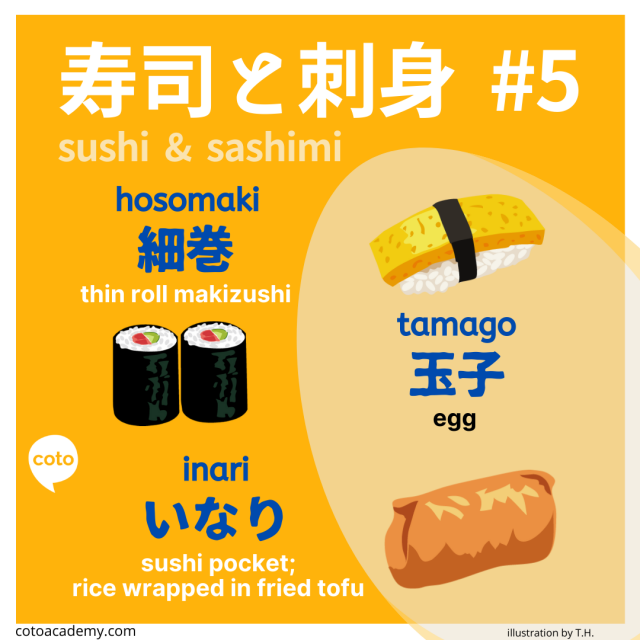
If you are not a fan of sushi featuring fish, you can segue to hosomaki (細巻き), which literally translates to “thin sushi roll.” Hosomaki diameter is around 3 centimeters, and there is usually only one ingredient inside. It’s thin and rolled with nori and looks like a gun, which is why it’s also sometimes called 鉄砲巻き (teppou-maki).
Some common hosomaki are below.
1. Kanpyoumaki (かんぴょう巻き): Dried gourd roll
Kanpyou is a dried, shredded gourd that has been simmered in a sweet soy-based sauce. Kanpyoumaki is a traditional sushi roll featuring these tender, slightly sweet strips rolled with sushi rice and seaweed. It’s a classic ingredient in Edo-style sushi and offers a subtle, savory-sweet flavor.
2. Kappamaki (かっぱ巻き): Cucumber roll
Cucumber is actually “kyuri” in Japanese, but the name “kappa” refers to a mythical water creature in Japanese folklore that is said to love cucumbers. Hence, it is called kappamaki instead of kyurimaki!
Kappamaki is a simple and refreshing sushi roll filled with thin strips of crunchy cucumber. It’s light and crisp, making it a popular choice as a palate cleanser or a vegetarian option.
3. Nattoumaki (納豆巻) Fermented soybean roll
Who hasn’t heard of natto, that famously gooey, sticky fermented soybean? It might look a little unusual and have a strong smell, but it’s incredibly healthy and packed with nutrients. Nattoumaki is a sushi roll filled with this unique ingredient, offering a savory and slightly pungent taste.
4. Tekkamaki (鉄火巻): Sliced raw tuna roll
Tekkamaki is a classic sushi roll filled with fresh, sliced raw tuna (maguro). The word “tekka” means “red hot iron,” likely referring to the deep red color of the tuna.
There is also 太巻 (futomaki), which is a thick roll of makizushi. With a diameter above 5 centimeters, it can hold more than one kind of ingredient. The 玉子 (tamago) or egg sushi is often wrapped with some seaweed to hold it together. This is a sweeter piece of sushi, almost like a dessert!
Other Common Sushi Fish in Japanese
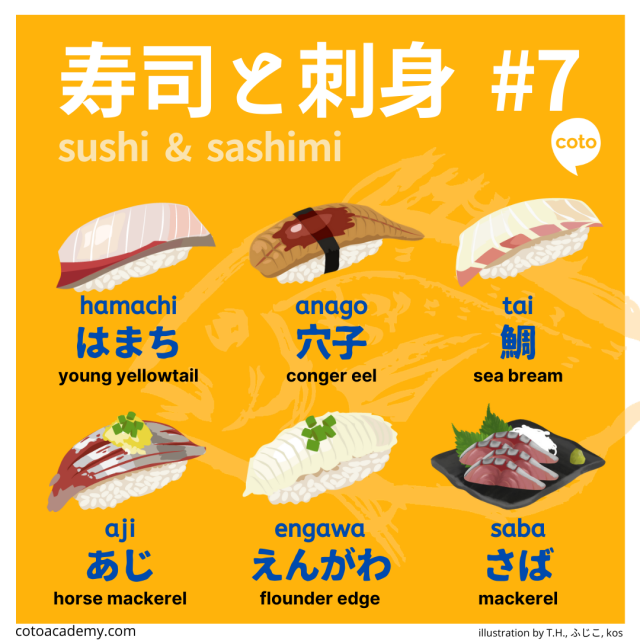
Beyond the usual salmon and tuna, there are other common types of sushi in Japanese.
1. Hamachi: Yellowtail
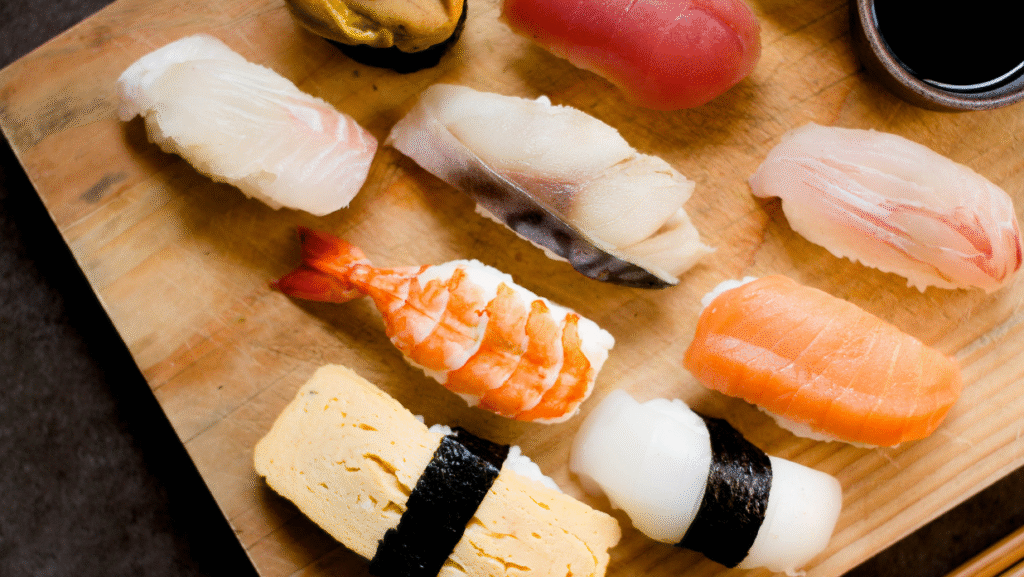
A tender, buttery fish commonly used in sushi, hamachi (はまち) refers to the younger stage of yellowtail and is popular for its mild flavor.
2. Anago: Conger eel
A staple in Edomae-style sushi, anago (穴子) is one of the few sushi toppings that is cooked rather than served raw. The eel is typically boiled or simmered to achieve a soft, delicate texture, then brushed with a sweet soy-based sauce called tare. Its mild, slightly sweet flavor and tender consistency make it a signature offering at many traditional sushi restaurants.
3. Tai: Sea bream
Tai (鯛), or sea bream, has a mild, clean, and slightly sweet flavor. It is a prized white fish in Japan, often served on special occasions.
4. Aji: Horse mackerel
Aji (あじ), or horse mackerel, is delicate and slightly oily, usually served with grated ginger, scallions, and a touch of soy sauce.
5. えんがわ: Engawa
Taken from the base of the fin of hirame (flat flounder) or karei (righteye flounder), engawa’s name comes from 縁側 (engawa), the porch-like edge of a traditional Japanese house, which the fish’s anatomy resembles. Only about 4 slices can be taken from one fish, making it a rare and prized cut with a chewy, rich texture.
6. Saba: Mackerel
Saba (鯖), or mackerel, is known for its bold, savory flavor. It is often served shime-saba (lightly pickled) to balance its natural oiliness and preserve freshness.
Ordering Sushi at a Restaurant in Japan
Sushi restaurants in Japan usually fall into one of 2 categories: Conveyor belt sushi (回転寿司) and over-the-counter sushi restaurants.
Conveyor belt sushi is fun and family-friendly, but the quality is often lower than the over-the-counter sushi. It is more affordable and more convenient, making it an excellent option for a casual dinner out! These establishments often have touchscreen menus available, so you can order as you go until you are full!
The over-the-counter sushi is an experience of its own. You can watch them make the sushi right in front of you before they pass it over the counter!
These restaurants often offer sets that are prepared by the sushi chef for your dining pleasure. You should eat the sushi as soon as you receive it for the best taste! Sushi can be eaten with either chopsticks (ohashi) or bare hands. Either one is acceptable!
Hopefully, this article was able to provide you with useful information about sushi in Japanese. Check out our guide on how to order sushi in Japanese.
Learn to order sushi fluently by taking Japanese lessons with us!
Visiting Japan and calling yourself a foodie? You might be interested in reading:
- How to Order at a Restaurant in Japan
- How to Order Take-out in Japan
- Guide To Japanese Cooking And Recipes Vocabulary
- How to Read Japanese Nutrition Labels
FAQ
What does sushi mean in Japanese?
“Sushi” (寿司 or すし) refers to a dish made with vinegared rice, often combined with fish, seafood, or vegetables.
How to say sushi in Japanese?
It’s pronounced “su-shi” (すし) in Japanese—same as in English, just with native pronunciation.
What is a common sushi in Japanese?
The most common sushi in Japan includes tuna (maguro), salmon (sake), shrimp (ebi), egg (tamago), cucumber rolls (kappa maki), and inari zushi, found everywhere from sushi restaurants to convenience stores.
